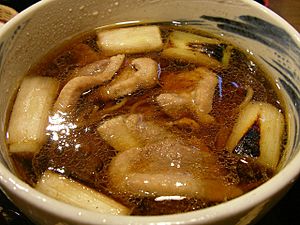Kamo Nanban facts for kids
Kamo nanban (鴨南蛮) is a popular Japanese noodle dish. It features warm soba or udon noodles served in a hot soup called dashi. The main ingredients are tender duck (鴨) meat and leeks or Welsh onions. Sometimes, if chicken is used instead of duck, it's called tori nanban (鳥南蛮) or kashiwa nanban (かしわ南蛮).
Contents
What is Kamo Nanban?
Kamo nanban is a type of "kake soba" (かけそば), which means it's a noodle dish served in a hot broth. You'll often find it on the menu at Japanese soba restaurants. It's usually a bit more expensive than some other noodle dishes. Many people say that the duck meat tastes best during the winter. This is because the duck is fattier and more flavorful then. It's also often served with special seasonal soba noodles, which are perfect for colder days.
Why is it Called "Nanban"?
The name "nanban" has an interesting history. It comes from the use of duck and onions in the dish. During the Edo period in Japan, people from other countries, called the Nanman, arrived. They were known for enjoying onions to stay healthy. Because of this, onions in dishes sometimes became known as "nanban."
Another idea is that "nanban" was used for anything new or unusual. A scholar named Kitamura Nobuyo (喜多村信節) wrote that things that were different from the past were often called "nanban."
In the Kansai region of Japan, Kamo nanban is sometimes called kamo nanba (鴨なんば). This is just a slightly different way of saying "nanban." In Osaka, Welsh onions were even called "nanba" because a famous area called Nanba (難波) grew a lot of them.
If a restaurant serves both soba and udon noodles, they might write kamo nanban soba (鴨南蛮そば) to show it's the soba version. This helps you know it's different from kamo nanban udon (鴨南蛮うどん), which uses udon noodles but has the same duck and onion flavors.
A Look Back: History of Kamo Nanban
The idea of eating noodles with a hot soup became popular in the middle of the Edo period. This was called Bukkake soba (ぶっかけそば). The special addition of duck and Welsh onions, which makes Kamo nanban, is thought to have started at a restaurant called Sasaya (笹屋) in Nihonbashi. People loved the taste of the duck and fried Welsh onions cooked together.
A book from the late Tokugawa shogunate period, Morisadamankō (守貞謾稿), also mentioned Kamo nanban. It described it as "Duck with onions. A specialty of winter." For a long time, Kamo nanban was made only with wild duck. It wasn't until the end of the Meiji era that domestic duck (ducks raised on farms) started to be used in Japan.
What's in Kamo Nanban?
Kamo nanban uses either domestic duck or wild duck. Since wild duck is hard to find, most restaurants today use ducks raised on farms. Chefs often use both the juicy thigh meat and the soft breast meat of the duck.
For the onions, long Welsh onions are usually chosen because they go well with duck. Sometimes, the onions are just warmed quickly in the soup. But many people think it tastes best if the onions are first fried or roasted in sesame oil. They are often cut into round slices about 5 centimeters (2 inches) long.
To add extra flavor, people might use chilli pepper or yuzu, which is a type of citrus fruit.
Kamo Nanban in Instant Noodles
You can even find Kamo nanban as an instant noodle dish! In 2003, a company called 'Acecook' released the first Kamo nanban instant "cup noodle." Later, in 2009, Nissin Foods also released their own duck stock soba version.
Other Dishes Like Kamo Nanban
Kamo Nuki
This dish is like Kamo nanban but "without duck." It's often enjoyed as a snack with drinks. The duck meat gives it a special flavor.
Kamo Seiro
Kamo seiro is a dish with cold, cooked soba noodles. You dip the noodles into a warm sauce that has duck meat and Welsh onions. This dish is said to have been created in 1963 at a restaurant in Ginza called Chōji-an.
Kamo Nanban Udon
This is simply the warm version of the dish using udon noodles instead of soba, but with the same duck and Welsh onions.
Tori Nanban
This is a similar noodle dish that uses chicken instead of duck. It's also sometimes called kashiwa udon. It's important not to confuse this with "Chicken nanban," which is a completely different dish made with fried chicken cutlets and onions, not noodles.




